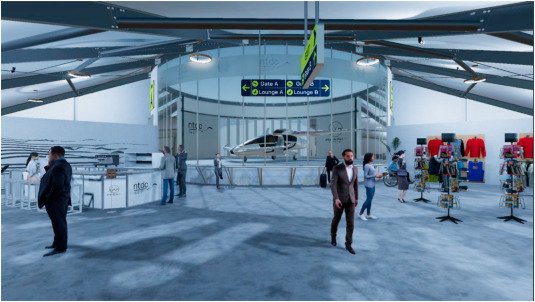Urban-Air Port’s collaboration with Coventry University: Experimenting with virtual reality to capture the Air One passenger experience
Urban-Air Port’s Founder Ricky Sandhu (Right) with Coventry University’s Stewart Birrell (Left) and Andy Street (Centre) Mayor of the West Midlands at the Air One event in Coventry.
- New research paper by Coventry University’s National Transport Design Centre (NTDC) examines the first use of Virtual Reality (VR) to evaluate the passenger experience and navigation of Urban Air Port’s (UAP) Air One.
- UAP designed and built Air One as a demonstrator in Coventry City Centre with funding from the United Kingdom Research and Innovation (UKRI).
- The NTDC collaborated with UAP during the early design stages to improve the customer experience before Air One was physically constructed
- The NTDC used a VR simulation of Air One to conduct user trials in 2021 during the Covid-19 pandemic.
- Conclusions demonstrate the benefits of engaging users during the early design stage to inform accessibility, navigation, and passenger flow throughout the vertiport. These conclusions have been reviewed by UAP for inclusion in future customer experience design strategies.
Urban-Air Port’s innovative vertiport technology, Air One, features extensively in a new paper written by Coventry University. This first of a kind study uses human factors research[i] and VR technology to inform the successful design of infrastructure to support future mobility. The Air One vertiport, built in Coventry City Centre in April of this year, served as a demonstrator of sustainable infrastructure for passenger air taxis and autonomous drones for advanced air mobility.
Designed to be ultra-compact, Air One captures the traditional airport environment and scales it down to fit within a condensed footprint, retaining key operational and passenger processing elements such as check-in and security, as well as retail and food and beverage areas to create an enjoyable traveller experience. A focal area of Coventry University’s experiment involved evaluating this passenger journey through analysis of interaction with the VR simulation.
UAP developed the Air One design early in 2021 for the UKRI’s Future Flight Challenge Phase 2 as part of a successful bid, working with a consortium whose members included Coventry City Council and Coventry University. During this period the UAP design team collaborated with transportation designers at the NTDC to build an immersive VR environment of Air One. UAP provided CAD (Computer Aided Design) models of the infrastructure, which NTDC used to create a 3D environment – much like a computer game – which volunteers for the study could then navigate using a VR headset.
Conducted during the Covid-19 pandemic and under safely controlled conditions, participants in the experiment were given ‘customer journey scenarios’ to complete, for example, visit the Urban-Air Port Café, buy a coffee and then go to your gate to board an eVTOL (Electric vertical take-off & landing) vehicle. Users were then asked to navigate the virtual Air One using signage and wayfinding created by the NTDC. An analysis of the volunteers’ reactions and responses to the virtual environment was assessed to ascertain the level of accessibility and ease of navigation, providing an insight into the effectiveness of the vertiport layout and wayfinding system throughout the infrastructure, a key element in vertiport customer experience.
First person VR view of the Air One infrastructure, insert shows the experimental setup
“We’re delighted that Air One has played an important role in Coventry University’s research into future mobility infrastructure and human interaction. At Urban-Air Port we believe customer experience is key. Our mission is to bring seamless zero-emission journeys to our towns and cities – cleaner, greener and quicker intermodal travel – utilising a more compact vertiport footprint to provide all the benefits of a traditional airport. Our collaboration with Coventry University’s NTDC during FFC2 has resulted in another world-first with the publication of their research. We’re confident these findings will prove invaluable in helping to shape the customer experience design for future Urban-Air Ports.”
“Working with Urban-Air Port at the early design stages of the Air One vertiport ensured that we could maximise the usability and customer experience of this future transport infrastructure. Through our innovative use of VR to realistically represent how a user might interact with the vertiport, we could gain an understanding of ‘people exciters’ and ‘pain points’ for future air travel. With this knowledge, we could re-design the user experience for Air One to be accessible, easy to navigate and a pleasure to use.”
As Urban-Air Port works with closely with regulators and agencies on certification of vertiport design, human factors research plays an important role in enhancing the passenger experience and accessibility through wayfinding and navigation within future mobility infrastructure solutions. Urban-Air Port looks forward to continue working with Coventry University and the NTDC to explore innovative research methods to engage with future passengers and enhance the design of the customer journey.
To read the fully published research paper by Coventry University please visit the following link: https://www.sciencedirect.com/science/article/pii/S0003687022001661
Discover more about the Air One event on the Urban-Air Port website: www.urbanairport.com/airone
For more information please contact the Urban-Air Port team:





